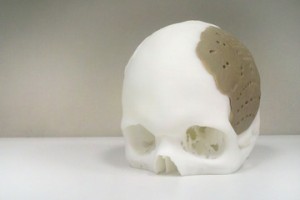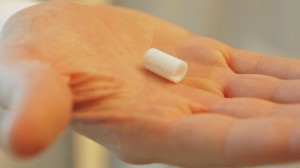Last week, we talked about all of the awesome and geeky things you can do with 3D printing. While that’s pretty cool, I feel the need to honor the more serious (yet equally awesome) uses of 3D printing technology: revolutionizing the field of medicine with printed prosthetics.
Prosthetics are incredibly expensive. The cost of materials aside, each person needs a completely unique prosthetic device. Since they can’t be made in mass, they often have to be hand crafted, after which a doctor has to make sure that the device fits.
But with 3D printing, prosthetics are actually surprisingly affordable. A digital scan of the patient can be turned into an object that fits them perfectly – all for a fraction of the traditional cost.
Still don’t believe just how much a printed prosthetic can change someone’s life? These are just of the few amazing technological innovations made possible by 3D printing.
1) Skull Implants

Image credit TechNewsDaily
Few bones can be considered as inherently vital as the skull. Its function is so important, yet it’s fragile enough to shatter upon impact. Unfortunately, no skull has a perfect shape, which makes skull transplants nearly impossible.
Luckily, 3D printing has made it possible to scan someone’s scull, and create a piece that perfectly fits the gap. According to an article by Oxford Performance Materials, one successful patient actually had 75% of his skull replaced with prosthetic material – all designed to fit him specifically.
2) Printed Prosthetic Covers

Image credit Bespoke Innovations
Humans are symmetrical creatures; and when we look at another person, we expect to see some of that symmetry. This is part of the reason prosthetic limbs are so glaringly obvious. It’s also a problem for many amputees; even if they can function normally, they still have a hard time adjusting to the fact that one of their limbs is just gone.
Bespoke Innovations, a company from San Francisco, has decided to change this. They will take a computer scan of your surviving limb, and use it to create a cover for your prosthetic. These covers don’t affect the function of the device, but the do change the look and feel of it – helping the prosthetic feel more like a real limb, or turning it into a work of art.
These covers, or “fairings”, are rather pricey, costing between $4,000 and $6,000. But for many people, that price is worth the feeling of being whole again.
3) Airway Splints

Sample airway stent – image credit NPR
Tracheobronchomalacia is a condition in which the airways are too weak to support themselves. This means that the patient’s lungs can collapse randomly, stopping breathing. The condition is often treated by applying a stent, which forces the airway to remain open. But since every set of lungs is different, each stent has to be custom made to ensure that it fits; this can’t always be done in time to save the patient.
In 2012, a doctor in Ohio tried something risky, and took a scan of his patient’s lungs. He then used that information to print a custom splint that was guaranteed to fit. The patient, who was only a few months old at the time, has now gone an entire year without having a breathing episode. If that’s not an amazing use of technology, I don’t know what is.
Do you know of a cool way that 3D printing has helped the field of medicine? Feel free to share it in the comments.
